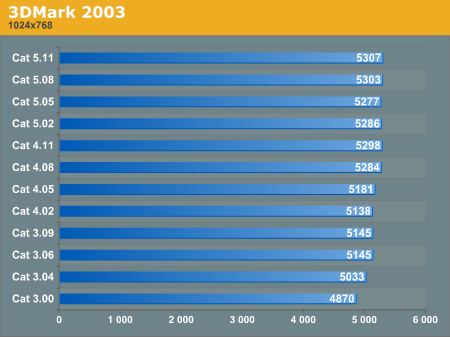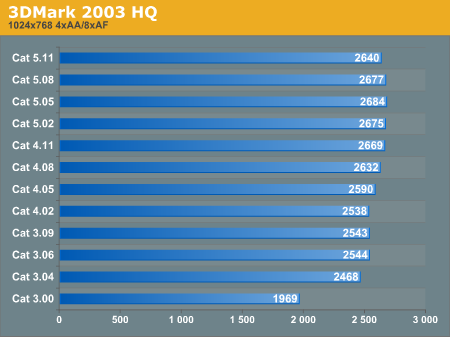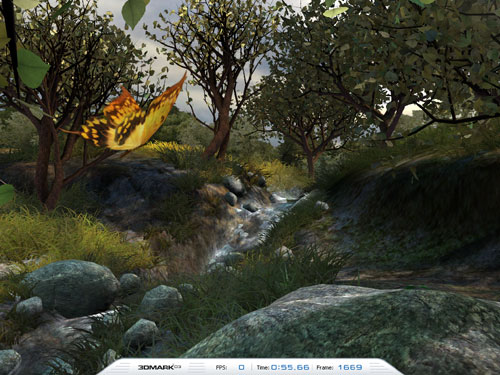Looking Back: ATI's Catalyst Drivers Exposed
by Ryan Smith on December 11, 2005 3:22 PM EST- Posted in
- GPUs
3dMark 2003
3dMark is not a benchmark that we routinely bring you here at AnandTech, as our editorial policy is to bring you benchmarks from real-world games and engines, and not synthetic metrics. That said, it would be inappropriate to leave out 3dMark in this case due to the significant cheating incidents with it. And, as a flashy, system draining benchmark backed by a unique database for comparisons, it's still an important title in the eyes of many consumers, OEMs, and the GPU makers looking for bragging rights.
With 3dMark, its importance in this regression is not so much the performance improvements as a sign of what happened with the card - the improvements were most certainly exaggerated due to in part by the synthetic nature of the benchmark - but rather a possibility of what can happen when ATI dedicates its resources to a game/benchmark that it considers most important. We should note that ATI has admitted to "cheating" on 3dMark 2003; however, these were what we consider honest shader-replacement optimizations (same mathematical output) that ATI voluntarily removed, though they were apparently re-introduced at some point. We used the latest version of 3dMark 2003, so this "cheat" was not activated in the older drivers.
For these benchmarks, 3dMark was run at its default resolution of 1024x768.
Overall then, 3dMark is much like Halo, a benchmark that received a slow, but steady improvement, without any fixes.
3dMark is not a benchmark that we routinely bring you here at AnandTech, as our editorial policy is to bring you benchmarks from real-world games and engines, and not synthetic metrics. That said, it would be inappropriate to leave out 3dMark in this case due to the significant cheating incidents with it. And, as a flashy, system draining benchmark backed by a unique database for comparisons, it's still an important title in the eyes of many consumers, OEMs, and the GPU makers looking for bragging rights.
With 3dMark, its importance in this regression is not so much the performance improvements as a sign of what happened with the card - the improvements were most certainly exaggerated due to in part by the synthetic nature of the benchmark - but rather a possibility of what can happen when ATI dedicates its resources to a game/benchmark that it considers most important. We should note that ATI has admitted to "cheating" on 3dMark 2003; however, these were what we consider honest shader-replacement optimizations (same mathematical output) that ATI voluntarily removed, though they were apparently re-introduced at some point. We used the latest version of 3dMark 2003, so this "cheat" was not activated in the older drivers.
For these benchmarks, 3dMark was run at its default resolution of 1024x768.



Catalyst 5.11 versus 3.00 (mouse over to see 3.00)
Overall then, 3dMark is much like Halo, a benchmark that received a slow, but steady improvement, without any fixes.










58 Comments
View All Comments
Ryan Smith - Sunday, December 11, 2005 - link
With this article series, we're especially looking for feedback guys. We can't test every last game under the sun because of how long it would take, but if there's something you guys would like to see and a good reason for it, we'd like to hear about it for possible inclusion in a future regression.Questar - Monday, December 12, 2005 - link
Feedback?Learn to proofread.
Cygni - Tuesday, December 13, 2005 - link
Feedback?Dont be an asshole.
Scrogneugneu - Monday, December 12, 2005 - link
I would like to see that kind of test on another, more recent card.Why? Simply to test what the first driver revisions do in term of performance. The article already shows that later in the driver's life, there is little improvement made on performance... but that on early drivers, there is usually a good jump. Could it be possible to test with a newer card, with the drivers available at launch and up from there?
That way we could have a better idea of what to expect when we hear ATI or NVidia saying "we will optimise the drivers after the launch". Does every optimisation happens in the first release, the second, the five first... what release usually brings the best improvements, both on IQ and FPS?
Could be nice to see such an article :)
timmiser - Tuesday, December 13, 2005 - link
I don't think that would work because the older drivers (ie-Cat 3.0, Cat 4.0) won't support the newer card.Scrogneugneu - Tuesday, December 13, 2005 - link
Well, if you use the drivers available at the launch of the card up to the current release, I'm pretty sure they will all be compatible with the card, won't they? ;)The goal is not to see what improvements were made with Catalyst 3.0 to 5.12, but to see what improvements were made from the first driver available for the card to the latest. More importantly, to see WHEN were they made.
timmiser - Tuesday, December 13, 2005 - link
Well yes, you could do that, but then you have just a typical article about driver improvements over the last 5 or 6 months which every hardware site has done over and over again. What makes this article unique is they take an older video card and review older drivers so that we can see the driver improvement effect over the span of years instead of months.Scrogneugneu - Wednesday, December 14, 2005 - link
By more recent card, I didn't mean a ATI X1x00 card or a NVidia 7x00.I was more talking about something like the Xx00 series. These cards have seen a great number of driver release, and are still pretty recent.
Besides, this article showed us that the only improvements seen were generally at the early stage of the development of the drivers, or at that least later in the works, there's not much difference. So, we can assume that a year of different driver revisions would be enough to show us what kind of improvements are made.
timmiser - Wednesday, December 14, 2005 - link
Exactly, which is all information we didn't know until this article showed that.oopyseohs - Sunday, December 11, 2005 - link
The Athlon64 you used was socket 754, not 757. =]